The sedentary lifestyle typical of most modern people often leads to diseases of the musculoskeletal system. One is cervical osteochondrosis. Recently, this disease has become much younger and its symptoms are often found in people over the age of 25. If left untreated, the pathology can lead to dangerous consequences.
Causes of pathology

The main cause of cervical osteochondrosis is improper distribution of spinal load. The factors leading to this may be different. Suppose one is used to carrying a heavy bag on one shoulder, sleeping or sitting in the wrong position, and so on. These factors appear to be insignificant, but if they act for a long time, they lead to a completely logical consequence - osteochondrosis of the cervical spine.
Risk factors that increase the likelihood of pathology include:
- overweight;
- lack of physical activity;
- transmission of spinal injuries;
- posture disorders;
- foot pathology;
- deterioration of the blood supply to the cervical spine.
These causes lead to the improper position of the vertebrae. The weight is unevenly distributed on the vertebrae, so some parts of the cervical spine can withstand excessive strain. In response, tissue changes occur.
The following factors may also aggravate the situation:
- transmission of a serious illness or injury that leads to exhaustion of the body;
- constant stress;
- metabolic disorders in the body;
- insufficient use, excessive consumption or intestinal absorption of trace elements;
- occupational diseases (especially vibration diseases);
- genetic predisposition to osteochondrosis;
- scoliosis and other postural disorders;
- non-compliance with the drinking system;
- malnutrition;
- bad habits;
- pregnancy.
Most often, SHOX provokes a number of factors. Lifestyle, general health and the presence of background diseases play a role in its occurrence.
Symptoms of the disease
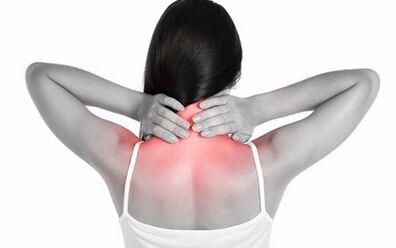
Even in the initial stage, the following symptoms can be recognized:
- pain in the neck, back of the head, arms, shoulders;
- weakness of the upper limbs;
- headache and crackling;
- general weakness and fatigue;
- frequent dizziness;
- lack of coordination;
- numbness of the tongue, hearing and vision impairment.
The most common symptom is dizziness. This can be accompanied by:
- ringing and noise in the ear;
- migraine;
- nausea and vomiting.
Patients often suffer from headaches, especially in women. Sometimes it manifests itself:
- anxiety;
- irritability;
- constant mood swings;
- sleep disorders.
How can a problem be diagnosed in this part of the spine?
SHOX is diagnosed by the following methods:
- X-ray. This method is not always effective, especially in the later stages of pathology.
- MRI. It allows you to view bone structures, hernias, their size and direction of development.
- CT. Computed tomography is less effective than magnetic resonance imaging because it is difficult to determine hernias and their size with this method.
- Ultrasonic duplex scanning. This method is used when there is a suspicion of impaired blood flow in the arteries. Scanning allows you to assess the speed of blood flow and the presence of obstructions.
Peculiarities

The disease can continue in different ways. Sometimes you compensate yourself, sometimes exacerbations appear.
Along with the pathological process, there are compensatory mechanisms that prolong the function of the vertebrae for a period of time and eliminate the symptoms. But as the disease progresses, it leads to the destruction of the fibrous ring and the appearance of microcracks. Vertebrae lose their fixation and stability.
In addition, osteochondrosis is characterized by impregnation of the intervertebral pulp with calcium. In view of this, a kind of hernia occurs as the vertebrae of the person concerned are pressed into the body of the person next to him.
The structures wear out over time, resulting in massive ossification.
Platoon
The course of the disease is divided into several stages:
- Section 1.Instability of vertebral structure and disc disturbances.
- Section 2.Decreased fixation of vertebral sections, protrusion of the disc.
- Section 3.Tibial fibrosis rupture, obvious symptoms and pain.
- Section 4.Difficulty moving, severe acute pain, widespread bone tissue.
Due to the peculiarities of the location of blood vessels and muscles, the neck is a vulnerable area. The long course of osteochondrosis presents a number of complications, many of which pose a serious threat to human health.
How to provide first aid at home?
Home treatment of cervical osteochondrosis includes:
- medicines;
- physiotherapy;
- massage;
- physiotherapy;
- dietary correction.
Together, the therapeutic methods make it possible to achieve good results in the treatment of cervical osteochondrosis. The symptoms of the disease can cause serious discomfort, so you need to know how to provide first aid.
Medicines
Various medications are used to combat the symptoms of the disease. These should be prescribed by a doctor who specializes in the treatment of osteochondrosis - a neurologist or a vertebrologist.
Medicines

- You can take painkillers for severe pain. If they do not work, NSAIDs can be taken.
- Sometimes "distractions" are used, such as pepper stain. It does not heal on its own, but warms the inflamed area and relieves pain.
- Herbal infusions and diuretics are useful for edema in the area of inflammation.
The following groups of medicines are prescribed for the treatment of SHOC:
- Non-steroidal anti-inflammatory drugs. It helps relieve pain, swelling and inflammation in the affected nerve root.
- Vitamins B. They help to improve the metabolic processes of nerve tissues.
- Chondroprotectors. Helps to restore cartilage tissue.
- Muscle relaxants. It helps reduce muscle cramps.
- Drugs to improve blood flow and rheological properties of blood. They help improve the blood flow process in the brain and the nutrition of the affected nerve endings.
Intramuscular injections may also be indicated.
Ointments

Ointments for osteochondrosis help to eliminate unpleasant symptoms in the early stages of the pathology. They are classified according to their effect on the body:
- Anti-inflammatory.The formulations contain non-steroidal anti-inflammatory drugs that help relieve pain and improve capillary permeability, reducing inflammation, swelling and redness.
- Heating.Such ointments have a number of contraindications, but are very effective in some cases.
- Complex preparations.The devices in this group relieve pain and inflammation and have antithrombotic and antimicrobial effects. They immediately penetrate the tissues of the joints, normalizing blood flow.
- Plant based products.The advantage of such ointments is the naturalness of the composition. But you have to use them for a long time.
- Chondroprotectors.These types of devices protect cartilage tissue from negative factors. Ointments include chondroitin, glucosamine. They activate tissue repair processes and reduce inflammation. We recommend that you use them 2-3 times a day after massaging the neck area a little earlier.
Massage

Massage strengthens muscle tone and relieves pain. His technique is chosen depending on the stage of the disease. But in most cases, all the techniques of classical massage are used: rubbing, caressing, kneading, etc.
- If the patient’s pain occurs on only one side, the massage starts from a healthy area, gradually moving to the site where the pain occurs.
- The very first session should be no more than seven minutes long. Each procedure is then incremented by 1-2 minutes until the session time reaches 12 minutes.
- The patient should be in a supine position, with his forehead placed on the cysts and arms, and his chin extended toward his chest. It is important for the neck muscles to relax.
Alone
The massage can also be done at home, but in this case you have to be very careful not to hurt any more. Self-massage with SHOX includes the following classic techniques:
- Caress.The massage begins by stroking the collar zone from the lymph to the armpit and supraclavicular nodes. The flat and comb-like sequence is then caressed.
- Recumbent supports.Place your hand on your neck and move it down your spine. Reclining supports can also be made with the edge of the palm towards the shoulder joints.
- Rubbing.It is used to warm and relax the muscles. The massage begins at the bottom of the skull. They make straight and circular movements with their fingers. Sawing movements can also be performed with the palm parallel to the ribs.
- Kneading.The neck is stretched in a circular motion.
- Vibration.The massage ends with shocks and vibrations by shaking and tapping.
Physiotherapy
Physiotherapy helps to improve the patient's condition. But it will be the safest during the recovery period. During the execution, the patient should not feel pain and discomfort. The purpose of the exercises is to strengthen the neck muscles.
Complex training therapy
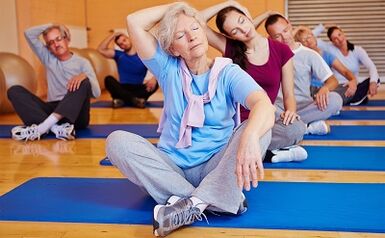
The gymnastic complex should be selected by a physician. The following exercises are useful:
- In a bent position, you should rest your hands on the floor and slowly raise your head while keeping your back and torso straight. You should stay in the top position for a few minutes and then return smoothly to your starting position. Perform 2-3 repetitions.
- You should be lying on your stomach, your arms outstretched along your body. The head turns first first and then right. Try touching the floor with your ear. At least 6 repetitions must be performed on each side.
- In a sitting position, you should bend down when inhaling to touch your chest with your chin, then lean back when exhaling, throwing your head back. The number of repetitions is 10-15.
- You have to press your forehead with the palm of your hand and resist with your forehead for 30 seconds. After the exercise should be repeated, pressing the back of the head with your hands clasped. The number of repetitions is 2-3.
- The smooth rotation of the head is performed sideways - 10 times each. Dizziness should be avoided during exercise.
Complementary therapy
The treatment can be supplemented with physical therapy methods as well as the use of various tools such as massagers.
Massagers
The use of massagers accelerates healing. It should be noted that they have a number of contraindications and can only be used with the permission of a doctor. In osteochondrosis of the cervical spine it is often used:
- applicator;
- warming massagers;
- tools for the neck and shoulders.
Applicator
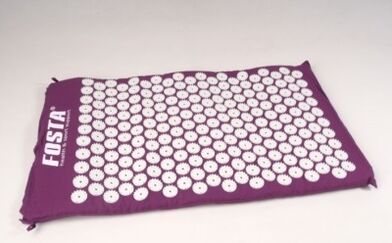
The applicator is a pillow or mat with plastic or metal spikes.
It acts on specific points that respond to all the biological processes in the body.
Using this product will help you achieve the following results:
- reducing or eliminating pain;
- improving cellular metabolic processes;
- relieving tension in the joints and restoring their tone;
- normalization of sleep.
Use the device according to the instructions.
Physiotherapy
The following methods can be indicated from the physiotherapy of SHH:
- Electrophoresis. . . It is combined with drugs that are immediately applied to the desired area under the influence of electric current.
- Ultrasound.Relieves pain and inflammation, improves metabolic processes.
- Magnetotherapy.Relieves tissue swelling, thereby minimizing pain.
- Laser therapy.It eliminates inflammation and improves blood circulation.
Folk remedies
Proven folk recipes can be used as an additional treatment.
Kerosene compress
A warming compress with kerosene helps to relieve pain quickly.
- The cloth should be moistened with a solution and applied to the affected area.
- Apply cotton or plastic wrap.
- Keep for up to three hours.
Rubbing from pharmaceutical preparations
- Five tablets of the analgin should be crushed.
- Add 15 ml of centrifuge, 0. 0000 l of iodine and camphor alcohol and mix thoroughly.
- The product is rubbed into the areas of the neck where pain is seen.
Pine bud infusion

Infusion of pine in the kidneys allows long-term remission to be achieved for a minimal period of time in pain caused by osteochondrosis of the cervical spine.
This drug must be prepared in advance and consumed for quite a long time, but the results will produce the expected effect for many months.
Preparation:
- The buds should be harvested before May. Cut into circles, place in a glass container and cover with 1: 2 granulated sugar.
- The drug should be administered for two weeks.
- You should take 0, 0005 liters three times a day, holding it in your mouth for a while, and only then swallow it.
The admission course is 2-3 weeks.
Potato compress
- 50 g of grated raw potatoes should be mixed with the same amount of honey.
- The composition is applied to a piece of natural tissue and placed on the neck.
You can get rid of the pain in three days.
Radish dressing
- The radish should be filed on a fine file.
- Place the pulp between two thin pieces of cloth and place it on your neck, wrapped in foil or parchment.
- You can last as long as you have enough time and effort.
Honey knitting
- Mix 15 grams of honey and chopped salt.
- The composition is applied to a piece of natural material and placed on the affected area.
- The top should be sealed with paper and wrapped in something warm.
Repeat the procedure every night.
Softwood broth
- Pour 250 grams of young pine or spruce needles with one liter of water.
- Cook for half an hour.
- The liquid should be taken twice a day, 35 minutes after a meal.
The therapy lasts for a month.
Dandelion broth
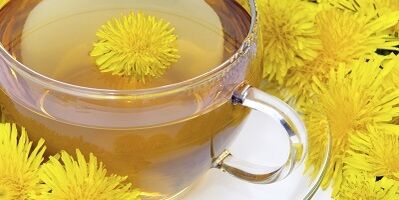
The most important medicinal properties of dandelion are related to the content of inulin, a large amount of amino sugar, natural rubber.
The plant is evaluated for its glycoside -taraxacin, triterpene compounds, fatty oils, organic acids and alcohols, resin compounds, bioflavonoids, and a number of mineral compounds, including the required calcium content.
Preparation:
- The roots of the dandelion must be ground to obtain 15 grams of product.
- Pour into 250 ml of hot water and leave in a boiling water bath for 15 minutes.
- The broth should be infused for 55 minutes, then filtered and water added until the original volume returns.
- Take 75 ml three times daily before meals.
Ginger ointment
- Grind the ginger root, weighing about 55 g.
- Add 30 ml of soft butter and 3 cloves of garlic.
- The agent is applied to the affected area to warm up.
Egg mixture with mustard
Mix:
- 50 g mustard powder;
- 3 egg whites, beaten;
- 50 ml of camphor alcohol;
- 59 ml of vodka or medical alcohol.
The product is infused in a dark place for 10-12 hours.
To make the second mixture, mix:
- 100 g of honey;
- 50 g aloe juice;
- 150 ml of vodka or dilute alcohol.
The preparation is placed in a dark place for 12 hours.
The funds are applied twice a day to the affected area and remain there until they dry out. It is recommended to combine them until they run out. The 12-day course will help you forget about the pain for several months.
What to do in case of severe pain?
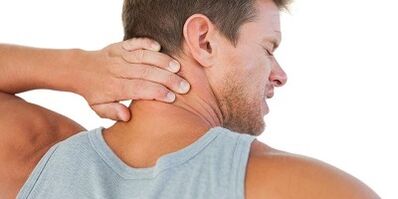
- In case of severe pain, you can take an anesthetic or an NSAID. Ointments give fast results.
- The class concerned must be at peace.
- A warm or, conversely, a cold compress will also help. In this case, moderation is important so that the effects of low or high temperatures do not increase pain and swelling.
It should be noted that therapy for osteochondrosis must be performed in a complex manner.
First, you need to remove all the pain in your neck and head, eliminate the root causes of discomfort.
If the patient is treating extremely severe pain, there is no way to get rid of the main problem.
Relieving dizziness
- If dizziness occurs, the patient should be placed or implanted to keep the neck as loose as possible.
- If you faint, place the patient in a horizontal position and lower your head.
Medications help:
- muscle relaxants;
- vasodilators;
- anti-inflammatory and analgesic drugs.
Gymnastics and physiotherapy are also helpful in treating dizziness.
Prevention of exacerbations
To prevent exacerbations, it is important to follow the following recommendations:
- Moderate exercise is helpful. They help improve blood circulation and lymph flow in the collar zone, improve vertebral mobility and prevent degenerative lesions.
- Nutrition plays an important role. No special diet is required, but it is recommended to limit the use of salty and spicy foods, sugar, foods containing artificial ingredients. The diet should include enough protein, vitamins, minerals and plant fiber. It is also important to consume a lot of water.
- Regular orthopedic check-ups are required.
- If you are overweight, you need to get rid of it.
- When transporting weights, the load must be evenly distributed.
- Those working on the computer should do regular warm-ups.
- It is important to check your posture, try to avoid stress, injury and hypothermia.
Advice from doctors and patients

Professionals and patients with osteochondrosis of the cervical spine also provide the following advice:
- Do not self-medicate in case of acute pain. A doctor should be consulted as soon as possible to develop a comprehensive treatment system, taking into account the specific case.
- Do not try to correct a dislocated vertebra yourself and take large amounts of painkillers. Self-healing can only make the condition worse.
- An important measure of the exacerbation of osteochondrosis is the motor system. Rest and restraint are needed in the first days, but motor activity should increase in the future. Special exercises are useful.
- It is important to quit smoking. This also applies to the treatment and prevention of the disease. Due to the effect of cigarette smoke, the blood vessels are affected, blood circulation deteriorates, and metabolic processes slow down. As a result, the risk of developing degenerative processes in different parts of the spine increases.
The symptoms of osteochondrosis of the neck are quite unpleasant. If they appear suddenly and cause serious discomfort, you can use first aid measures in the form of painkillers or folk remedies. But it should be understood that these methods only alleviate the condition but do not cure the disease. To get rid of osteochondrosis, you need to visit a specialist and follow the complex treatment regimen he or she prescribes.



























